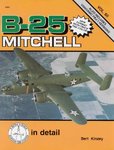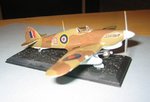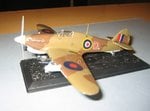I read a little last night. The Russians added a 37 mm cannon on some of the planes. The Kansas City factory started adding the waist gun positions to the later blocks of the D models and installed the first tail gun postions with a single .50 cal. The waist guns were not used on the G models but were picked up again on the H after the turret was moved forward.
DBII
From Jerry Scutts book -
"Data compiled on Axis fighter interception of Allied bombers during World War II invariably recorded numerous attacks from directly aft. Any bomber without extreme tail defence was deemed to be that little bit more vulnerable to fighters, and in the case of the B-25, a number of C and D models had their armament increased by the installation of a single 'stinger' gun in place of the Plexiglas tail-cone. In addition, enclosed waist windows' were often located just aft of the wing, forward of the dorsal turret (which was retained), and a raised cockpit was provided for the tail gunner.
None of the early B-25C/D models was built with extreme tail defence, and it was left to service depots, forward maintenance units operated by Air Service Command, and workshops run by the combat groups, to carry out the modifications. All such units played a vital part in maintaining the flow of new and repaired combat aircraft to the operational squadrons, and all were capable of carrying out field modifications. In the case of the B-25 they were often concerned with armament changes. The tapered tail of the B-2SC/D left little space for the breech of a O.5in machine gun, and installing a machine gun usually meant chopping back the fuselage plates flush with the trailing edge of the tail plane to create the maximum possible space and improve the field of fire - which was, in any event, limited to a few degrees in azimuth, elevation and depression. To operate the gun from his 'open' position, the gunner had originally to lie prone. The installation of a cockpit over the tail plane allowed space for a seat, enabling him to sit upright, which was a considerable improvement. No identifying model number is known to have been allocated to these hybrid B25s - or indeed the total of aircraft involved - despite them being numerous, although the RAF did identify those machines it received as the Mitchell Mk IIa. When the larger waist windows were installed, individual aircraft also sported external bracing struts attached to the fuselage longerons as an added safety measure. Each window and its gimbal gun mount weighed several hundred pounds, and some crusty engineers doubtless felt that it was best to be safe rather than sorry."




